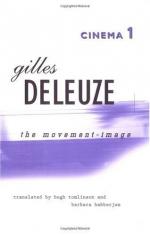
|
| Name: _________________________ | Period: ___________________ |
This test consists of 15 multiple choice questions and 5 short answer questions.
Multiple Choice Questions
1. Bergson referred to the occurrence during the first thesis of movement as which of the following?
(a) False movement.
(b) Pirvileged instants.
(c) Cinematographic illusion.
(d) perfected illusion.
2. What is the first pole of the face as Deleuze describes it?
(a) Individuality.
(b) Subjectivity.
(c) Quantity.
(d) Power.
3. Movement's third subdivision is into which category?
(a) Ideal-images.
(b) Solar-images.
(c) Medium-images.
(d) Affection-images.
4. What do "firstness" and "secondness" classify?
(a) Quality.
(b) Power.
(c) Communication.
(d) Quantity.
5. What does Deleuze describe as matter with dimensions in space?
(a) Qualitative non-extended images.
(b) Consciousness.
(c) Materialism.
(d) Idealism.
6. The view of a participating character is which of the following images?
(a) Affective factor.
(b) Active factor.
(c) Sensory factor.
(d) Cogito factor.
7. How does Deleuze define philosophy?
(a) Creation of a story.
(b) Creation of thoughts.
(c) Creation of concepts.
(d) Creation of film.
8. "Eye of the camera" was coined by who?
(a) Dos Passos.
(b) Deleuze.
(c) Mitry.
(d) Griffith.
9. Who does Deleuze credit as using the fourth law of dialect to affirm matter?
(a) Griffith.
(b) Gance.
(c) Eisenstein.
(d) Vertov.
10. Frame dovetail to demonstrate what kind of changes?
(a) Quantitative changes.
(b) Frontal changes.
(c) Cutting changes.
(d) Qualitative changes.
11. French filmmakers use machines to bring animate things together with which other type of things?
(a) Organic.
(b) Vehicular.
(c) Expressionist.
(d) Inanimate.
12. What term describes an image becoming liquid?
(a) Objectivity.
(b) Point to point.
(c) Dicisign.
(d) Reume.
13. Deuzel presents the idea that who or what is the indeterminate center?
(a) The individual.
(b) Matter.
(c) Movement.
(d) Perception.
14. Which filmmaker is described as introducing gaseous perception?
(a) Keaton.
(b) Vertov.
(c) Beckett.
(d) Gance.
15. What helps montage occur?
(a) Cutting.
(b) Fixed camera.
(c) Second level shot.
(d) Unity of movement.
Short Answer Questions
1. What country does Deleuze credit with organic schools?
2. What are the two poles in "The Perception Image"?
3. What are mobile sections of duration also known as?
4. The alternation of light and shadow replace what opposition?
5. Gance's film that is used as an example by Deleuze includes an example of which type of movement?
|
This section contains 329 words (approx. 2 pages at 300 words per page) |

|




